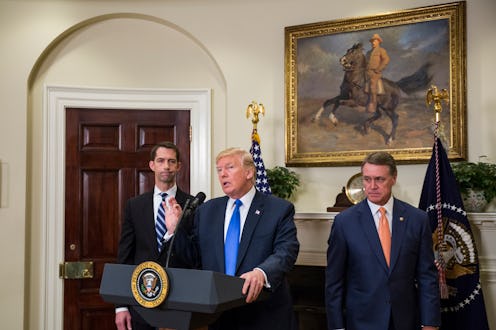News
This Is What The RAISE Act Is Actually Intended To Do

When it comes to immigration, President Trump has left little about his views to the imagination. While he hasn't yet delivered on his boisterous campaign promise to build a wall along the U.S. border with Mexico, the president this week announced his support for a different plan to slow immigration. The so-called RAISE Act would prioritize skilled workers for immigration to the United States through a merit-based process.
Known formally as Reforming American Immigration for Strong Employment Act, the RAISE Act was co-authored by Republican Sens. Tom Cotton of Arkansas and David Perdue of Georgia. Neither senator serves a border state, but immigration reform has remained on the Republican agenda for what seems like years. On Wednesday, the senators joined Trump at the White House, as the president officially announced his support for their plan.
In short, the RAISE Act would reimagine the American immigration system, prioritizing potential immigrants based on skills and merits. Educated, English-speaking applicants would receive priority and the bill would limit "chain migration," or immigration to the United States based on family relationships. The senators reportedly hope to cut legal immigration in half with their proposed plan. In announcing his support for the bill, the president on Wednesday called it a "historic and very vital proposal" that creates a "competitive application process."
The RAISE Act ends chain migration, and replaces our low-skilled system with a new points-based system for receiving a Green Card. This competitive application process will favor applicants who can speak English, financially support themselves and their families, and demonstrate skills that will contribute to our economy.
According to Trump's remarks, the RAISE Act also prevents new immigrants from collecting welfare and "will give American workers a pay raise by reducing unskilled immigration." However, those claims have been strongly disputed.
Perdue compared the RAISE Act's system to other immigration systems used internationally. "We looked at countries like Canada, Australia, and others," he said Wednesday. "What we're introducing today is modeled on the current Canadian and Australian systems."
Beyond the merit-based immigration system, the RAISE Act also includes provisions for refugees and asylum-seekers. According to the text of the bill, no more than 50,000 refugees would be permitted to enter the United States in a fiscal year. That's in line with the president's own attempts to cap the number of refugees permitted at 50,000 in one year. The proposal also limits the number of visas issued under the merit-based system to 140,000 per year. (For perspective, the United States reportedly issued more than 1 million green cards in 2015.)
Despite the headlines it generated this week, the RAISE Act has not moved quickly through Congress. It was introduced in the Senate back in February and has since been referred to the Judiciary Committee. It's likely that Trump's remarks in support of the bill this week were intended to move things along.